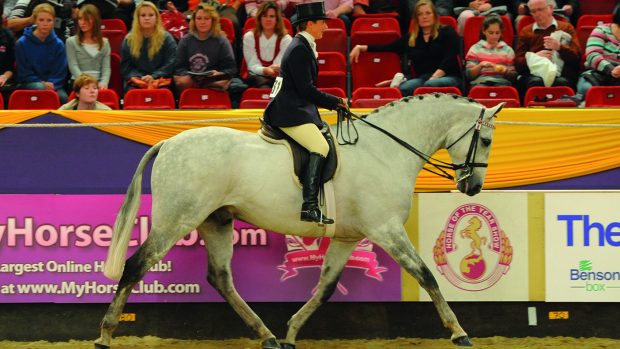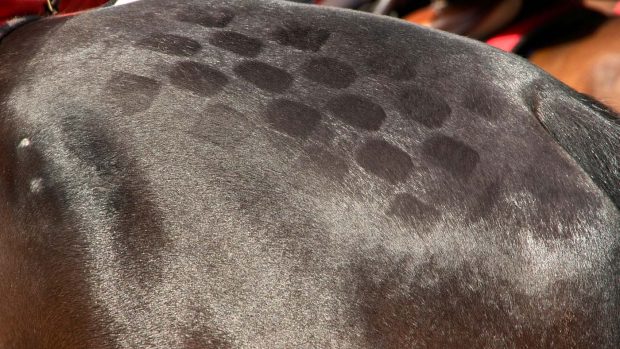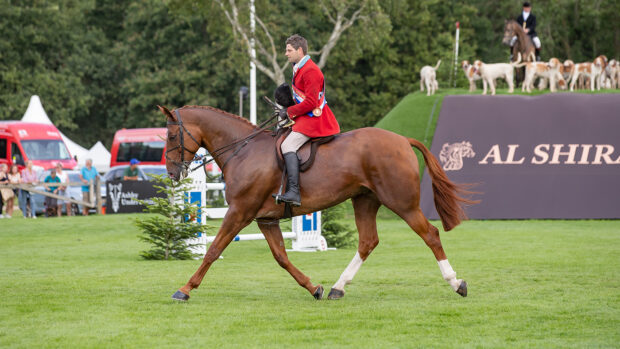Whether you’re a dab hand at showing or considering doing it for the first time, the following expert advice on how to show a horse in-hand from judges and producers will set you up for success.
If you’re showing a specific breed or a youngster, there are in-hand classes for all types of horses and ponies.
“There’s probably a class for every breed or type if you look at schedules,” says Emma Edwards-Brady, a judge for the British Show Horse Association (BSHA), the British Show Pony Society (BSPS) and the British Skewbald and Piebald Association (BSPA).
“Youngstock can be shown in hunter, hack and riding horse classes as well as sport horse breeding sections. Native breeds are also shown in-hand, as are foreign breeds, miniatures and veterans too,” adds Emma, who has successfully shown youngstock in-hand from her family’s Runnon Stud.
Why show in-hand rather than under saddle?
You may want to try something new with your horse, or the start of a breeding programme will lead you to the show ring.
“I think it’s a good idea to show youngstock in-hand a few times, even if it’s just to get them prepared for when they come out under saddle,” says Emma.
In-hand showing is also a useful shop window for promoting a specific breeding line.
“As a breeder you’re promoting your stud and other youngstock,” adds Emma. “With good results it will hopefully lead to getting better prices when you sell them on. Plus there’s not many age restrictions for showing in-hand so it attracts children through to grandparents alike.”
How to show a horse in-hand: five ways to prepare for the ring
1. Do your homework
“Your horse or pony must be used to being led in walk and trot in a nice outline,” says Emma. “Some horses naturally come on the bridle, but others need a little help. You might need to long-rein and/or use a roller and side-reins to encourage them into the correct outline.”
2. Making sure you are leading your animal correctly is imperative, stresses producer Jack Cochrane, who has won the prestigious in-hand championship at Horse of the Year Show (HOYS).
“You should be at the shoulder and have him in front of you,” explains Jack. “If the horse is strong, use a bridle to keep him in check. If he won’t go forward, have a long whip to keep him moving. This should be done daily when leading to and from the field.”
3. Should you find your horse keeps moving away from you while being led, Jack recommends doing the following training.
“Take him into a school or stand him up against a wall or hedge and lead him from the near side, but on the left rein so that he can’t move away from you. Gradually move away from the wall until you can trot him up and he stays straight. Then gradually change the rein until you have him going in a straight line.”
4. Make sure your animal is exposed to spooky objects in training so that they are less likely to react in the ring.
“If you’re doing a sports horse class make sure your horse is used to walking and trotting around poles and flower pots as they can sometimes look very scary, especially to a spooky, young animal,” says Emma.
5. Practice makes perfect
“Your animal shouldn’t be trying to rub, bite reins, looking for treats or fidgeting as it spoils the overall picture,” says Emma, who advises getting a friend to act as a judge.
“You need to get your horse used to standing still while the judge looks around him. Practice standing your horse square and make sure the judge will be able to see all four legs,” advises Emma.
How to stand your horse up correctly
When the judge is at the side
“The inside front leg should be slightly ahead of its other fore leg, and its outside hind leg should be slightly stretched back from the other hind leg, but the cannon bone should be vertical,” says Emma. “This should only be fractional so that the horse is still square and vertical.”
When the judge moves to the other side
“Move your horse forward or back a stride so it stands the same the other side. Make sure your horse’s legs are pointing straight — it’s very easy for a horse to stand pointing a toe out or in when stood up,” adds Emma.
Stand square
“Make sure there is a nice distance between the two front feet and the two back legs. You don’t want your horse to be to narrow, nor do you want to be able to push a wheelbarrow between its front legs.”
How to show a horse in-hand: top tips for the day
1. Carry a stick
“To help keep your horse straight when in the ring carry a smart stick and have it in front of you and up level with the horse’s nose,” says Jack. “If he tries to bend his head to the left, lift the stick towards his nose to help to keep him straight.”
2. Look interested
“Try to get your horse to prick his ears and look interested in life so that it shows off their front,” says Emma.
3. Keep out of the way
“When the judge stands in front of your horse make sure you stand to the side so the judge has a good view of your horse’s front,” adds Emma.
“Walk away and trot straight back passed the judge. I like to keep trotting until the judge has stopped looking, but always be aware of the line up of other horses in the ring,” noted Emma.
4. Turn correctly
Jack advises that the handler should walk straight away from the judge for about 20 yards and turn the horse away from you to the right. “The horse is then on the inside of the turn before you trot straight back towards the judge.”
5. Consider the terrain
“If the ring is on a slight hill try to walk down and trot up,” says Emma.
6. Stay straight
“Stand your horse on the flat as best as you can. Practice makes perfect so make sure your horse gets used to trotting towards someone in a straight line, some horses will be naturally cautious of trotting towards a stranger.
“A straight line might sound easy, but it still amazes me how many people can’t do it. Look up to see where the judge is before you start trotting. You don’t want to make your judge run around because you haven’t looked up to see where they are standing.
“The main aim is to have the horse straight. If his body is not straight, his legs will not move straight,” adds Jack.
7. Stay focused
“Remember at all times when in the ring the judge could be judging you,” states Jack. “Even when standing in the line-up, while the judge looks at the other horses, make sure your horse is standing up properly. The judge could keep looking back at your horse to compare it to the one in front of him at the time.”
8. Remember your manners
“Remember to always be polite and happy when in the ring – manners, both from horse and handler, go a long way,” concludes Emma.
You might also be interested in:

H&H’s guide to showing a small breed mountain and moorland pony
The following judges’ tips will ensure you make an instant impact and help you avoid unnecessary mistakes

H&H’s guide to show cob classes: from weight divisions to showing off correctly
How should you present a show cob correctly and how are the different weight categories defined?

H&H’s guide to show hunter classes: weight categories, presentation and what makes the judges cringe

Subscribe to Horse & Hound magazine today – and enjoy unlimited website access all year round
Horse & Hound magazine, out every Thursday, is packed with all the latest news and reports, as well as interviews, specials, nostalgia, vet and training advice. Find how you can enjoy the magazine delivered to your door every week, plus options to upgrade your subscription to access our online service that brings you breaking news and reports as well as other benefits.




